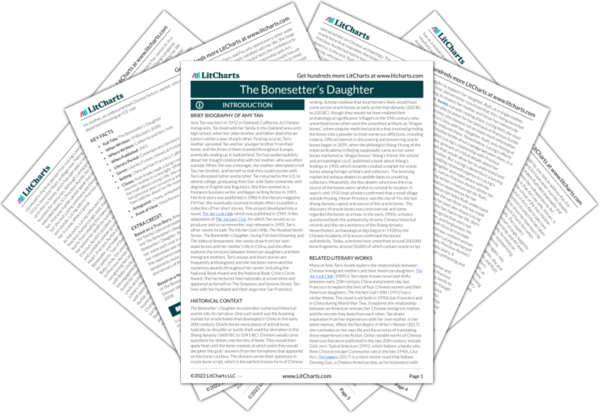The tea tray symbolizes generational trauma and the many ways it can manifest itself in a person’s life. When Ruth is six years old, she breaks her arm while playing at the school playground, and the shock of the injury causes Ruth to lose her voice. LuLing gives her a tea tray filled with wet sand in which she can trace letters with a chopstick. There is a clear parallel between Ruth's tea tray and the chalkboard LuLing used to communicate with Precious Auntie, who was also mute. The reappearance of this specific type of communication device symbolizes how family members can pass down certain behavior patterns, beliefs, and responses to trauma across generations.
The tea tray also symbolizes Ruth's complicated relationship to her voice and how her tumultuous formative years with LuLing taught her to silence herself. Although Ruth quickly regains her ability to talk, she chooses to remain silent after seeing how differently LuLing treats her when she doesn’t speak. Suddenly, LuLing cares about Ruth's opinions and doesn't mind when she "talks" back. When Ruth silences herself, LuLing rewards her with the affection and approval Ruth so desperately craves. When Ruth spells "B-U-R-G-E-R" in the tray, her mother cooks hamburger—unhealthy, unacceptable American food—for dinner, which she would never do under normal circumstances. By honoring Ruth's request, LuLing implicitly teaches her daughter to associate silence with reward and outspokenness with punishment. Furthermore, much of Ruth's experience with the tea tray occurs when she is physically capable of talking but chooses not to speak. By honoring the requests Ruth demands via the tea-tray, LuLing implicitly teaches her that she can avoid punishment if she lies convincingly enough—and that, in some circumstances, it is even advantageous to lie.
Lastly, the tea tray symbolizes Ruth's struggle to connect with LuLing. After a misunderstanding causes LuLing to believe that Precious Auntie is trying to communicate with her through Ruth's tea-tray writing, Ruth plays along and pretends to be Precious Auntie, trying to write the things she guesses LuLing would want Precious Auntie to say. Ruth doesn't wholly understand her mother's relationship with Precious Auntie (LuLing only alludes to her own complicity in the tragic nursemaid's horrific fate), but she wants to understand. More importantly, she wants to make her mother happy. However, Ruth's instinct to connect with her mother through clear-cut deception also shows how unapproachable LuLing is. Ruth's tea-tray hijinks show that it is easier for her to pretend to be the spirit of her mother's deceased nursemaid than to ask LuLing about her life.
The Tea Tray/Sand Quotes in The Bonesetter’s Daughter
“I hope you will still forgive me. Please know that my life has been miserable ever since you left me. That is why I ask you to take my life, but to spare my daughter if the curse cannot be changed. I know her recent accident was a warning.”
She recalled that when her younger self stood on this same beach for the first time, she had thought the sand looked like a gigantic writing surface. The slate was clean, inviting, open to possibilities. And at that moment of her life, she had a new determination, a fierce hope. She didn’t have to make the answers anymore. She could ask. Just as she had so long before, Ruth now stooped and picked up a broken shell. She scratched in the sand: Help. And she watched as the waves carried her plea to another world.












